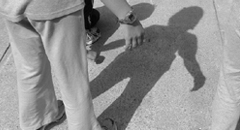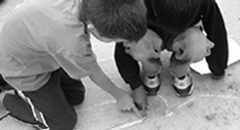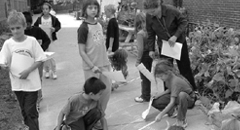
|

|

|
The following set of questions about learning in groups was generated over the course of two MLV Seminars from 2003-06. Here, they are grouped into three categories related to the overarching question, "How do learning groups form, function, and demonstrate
understanding?"
FORM
- How do learning groups form (e.g., in terms of their make-up, nature of their purpose or task, size, ability levels, etc.)?
- Why even work in groups? Couldn't individuals learn more on their own?/li>
- When is individual learning enhanced or stifled in a group?
- When and how do we make transitions from individual to group learning?
- What is the role of making personal connections or sharing personal information in a learning group?
- How can we involve students in the process of forming groups?
- How can we help adults come together as a learning group?
- What is the developmental path of how a learning group forms, functions, and demonstrates understanding?
FUNCTION
- How do learning groups function (e.g., with regard to such factors as the degree of member participation, racial, ethnic, and socio-economic diversity, etc.)?
- How does children's understanding of race and racism affect their learning in groups?
- How do we help children and adults think of themselves as learners in a group and why is this important?
- How can we change a group's identity, or an individual's identity in the group, especially if it is negative?
- How do we facilitate powerful group learning experiences that generate enthusiasm, motivation, creativity, and learning?
- What is the adult's role as a member of the learning group? How can teachers operate on the "two tracks of doing and documenting"?
- How do learning groups function when there is a wide range of abilities and skills in the group?
- What do you do if there is a tension between community-building (including everyone's ideas) and learning, or if an individual's ideas do not align with the group's?
- How can we develop a culture of critique in the classroom?
DEMONSTRATION OF UNDERSTANDING
- How do we know that the individuals in the group are learning?/li>
- When and how does a group create a collective body of knowledge?
- What is the relationship between MLV ideas and learning in the content areas?
- What is the students' role in making learning visible?
- In what ways can teachers and students share understanding goals?
- What helps a group get to a deeper level of understanding?
- How can making learning visible make learning possible?
- How can we use documentation to make students conversations and spoken insights more tangible and lasting in the classroom?
- What effects can making thinking visible on a classroom bulletin board have on student learning?
© 2003-06 Making Learning Visible Project at the Harvard Graduate School of Education
[Home] [Site Map]